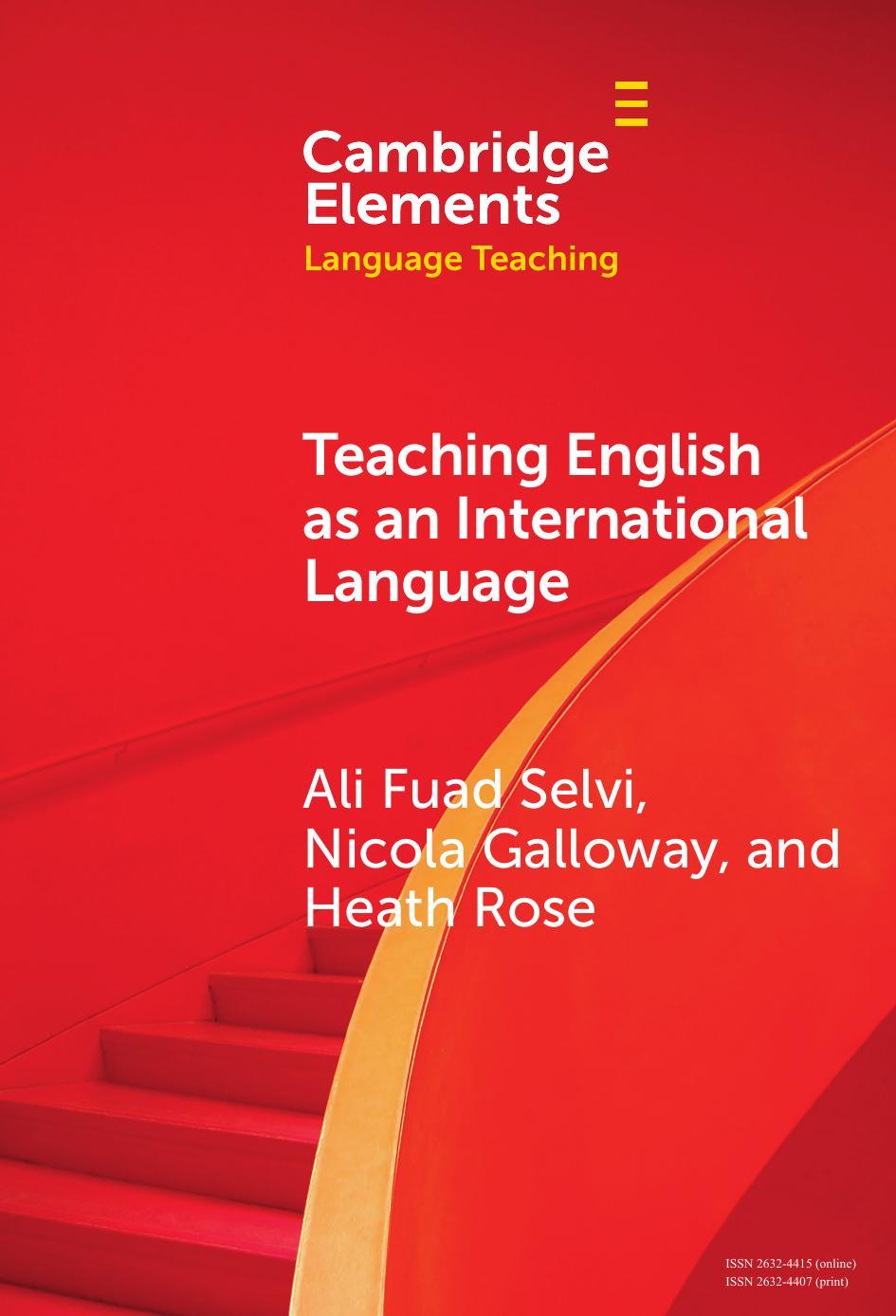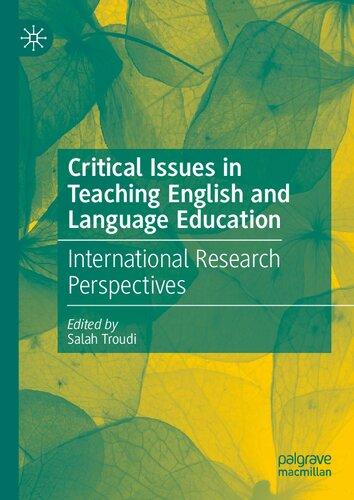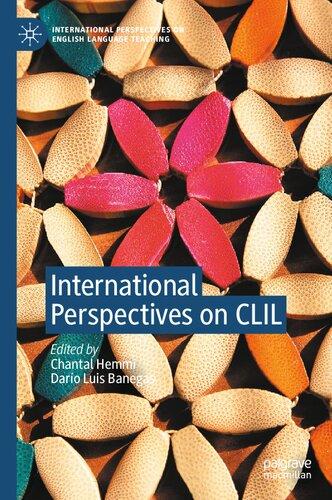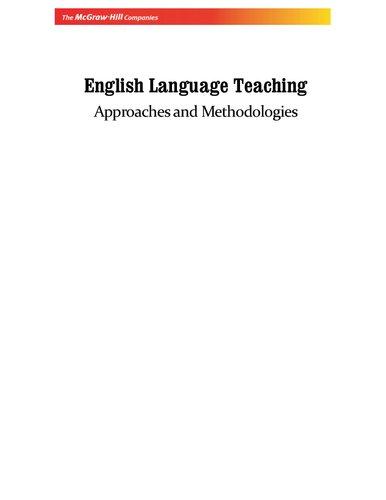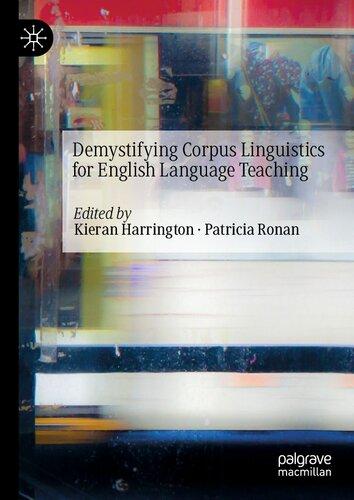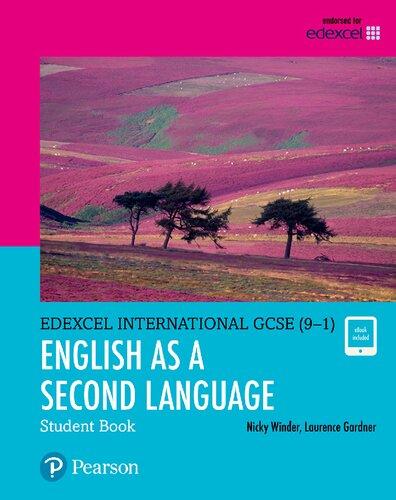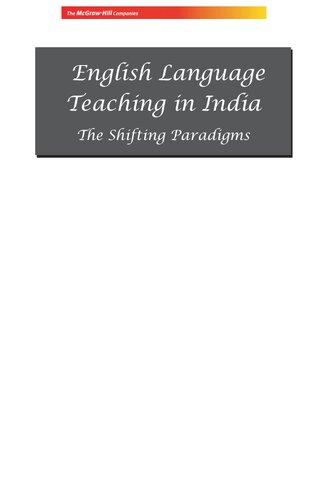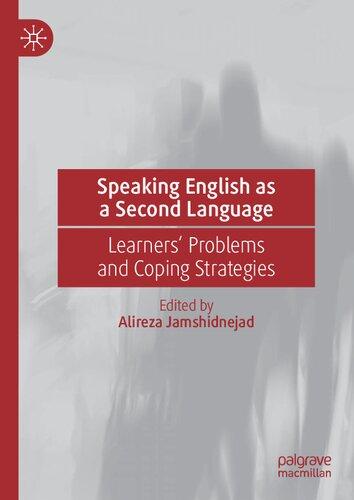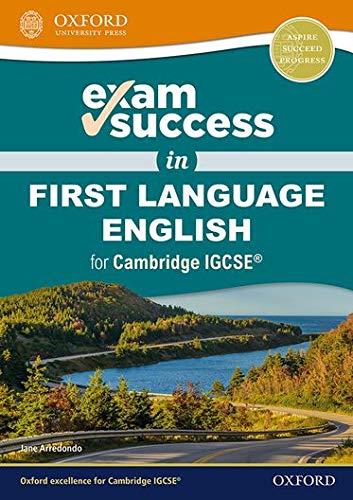ASANINTERNATIONAL LANGUAGE
AliFuadSelvi UniversityofAlabama
NicolaGalloway UniversityofGlasgow
HeathRose UniversityofOxford
ShaftesburyRoad,CambridgeCB28EA,UnitedKingdom OneLibertyPlaza,20thFloor,NewYork,NY10006,USA 477WilliamstownRoad,PortMelbourne,VIC3207,Australia
314–321,3rdFloor,Plot3,SplendorForum,JasolaDistrictCentre, NewDelhi – 110025,India
103PenangRoad,#05–06/07,VisioncrestCommercial,Singapore238467
CambridgeUniversityPressispartofCambridgeUniversityPress&Assessment, adepartmentoftheUniversityofCambridge.
WesharetheUniversity’smissiontocontributetosocietythroughthepursuitof education,learningandresearchatthehighestinternationallevelsofexcellence.
www.cambridge.org Informationonthistitle: www.cambridge.org/9781009462495
DOI: 10.1017/9781108902755
©AliFuadSelvi,NicolaGalloway,andHeathRose2023
Thispublicationisincopyright.Subjecttostatutoryexceptionandtotheprovisions ofrelevantcollectivelicensingagreements,noreproductionofanypartmaytake placewithoutthewrittenpermissionofCambridgeUniversityPress&Assessment.
Firstpublished2023
AcataloguerecordforthispublicationisavailablefromtheBritishLibrary
ISBN978-1-009-46249-5Hardback
ISBN978-1-108-82123-0Paperback
ISSN2632-4415(online)
ISSN2632-4407(print)
CambridgeUniversityPress&Assessmenthasnoresponsibilityforthepersistence oraccuracyofURLsforexternalorthird-partyinternetwebsitesreferredtointhis publicationanddoesnotguaranteethatanycontentonsuchwebsitesis,orwill remain,accurateorappropriate.
ElementsinLanguageTeaching
DOI:10.1017/9781108902755 Firstpublishedonline:December2023
AliFuadSelvi UniversityofAlabama
NicolaGalloway UniversityofGlasgow HeathRose UniversityofOxford
Authorforcorrespondence: AliFuadSelvi, afselvi@ua.edu
Abstract: ThisElementoffersacomprehensiveaccountofthe unprecedentedspreadofEnglishasagloballanguagebytaking historical,sociolinguistic,andpedagogicalperspectives.Torealisethis mission,itopenswithanaccessiblediscussionofthehistorical trajectoryoftheEnglishlanguagewithqualitativeandquantitative connectionstoitscontemporarydiversityintermsofforms,roles, functions,uses,users,andcontextsofEnglishasaglobaland multilingualfranca.Builtuponthissynchronic-diachronicsymbiosis, thediscussioniscomplementedbyanoverviewofmajoranalytical paradigmsandtrendsthatpromotesystematicalscrutinyoftheEnglish languageanditssociolinguisticandeducationalimplications.Itends byshowcasinginstructionalpractices,recommendations,reflective questions,andfuturedirectionsforlanguageeducatorstorevamptheir beliefs,commitments,andpracticesinlightofthechangingneedsand realitiesofthepresent-dayglocalsociolinguisticecologyand individualstherein.
Keywords: teachingEnglishasanInternationalLanguage,EnglishasaLingua Franca,WorldEnglishes,GlobalEnglishes,GlobalEnglishesLanguage Teaching
©AliFuadSelvi,NicolaGalloway,andHeathRose
ISBNs:9781009462495(HB),9781108821230(PB),9781108902755(OC)
ISSNs:2632-4415(online),2632-4407(print)
1Background:MorethanaFirst,Second,orForeign
1Background:MorethanaFirst,Second,orForeignLanguage
Recentstatisticsindicatethatmorethan7,000languagesarespokeninthe worldtoday(Eberhardetal.,2023).Eachoftheselanguagescomesinvarious forms,functions,sizes,and flavoursandopenslinguisticwindowsontorich social,cultural,andhistoricalvalues,meanings,andrealitiesaboutthepeople ofourplanet,bothpastandpresent.Theyembodyandanimateintangible culturalheritageaccumulatedoverthousandsofyearsofhumanexperience, interaction,andtradition.Ofalltheselanguagesformingthe ‘contemporary globallinguisticecology’ (Phillipson&Skutnabb-Kangas,1999,p.20),onehas aunique,unprecedented,andglobalstatus – theEnglishlanguage.
Builtupontheforcesofmercantilism,colonialism,culturalandeconomic globalisation,transnationalmovement,andtechnologicalinnovations,theglobalspreadofEnglishhasresultedindiverseforms,roles,functions,uses,users, andcontextsaroundtheworld.ThedevelopmentaltrajectoryoftheEnglish languagebeyondtheBritishIslesthathasbeengrowingsincethemid-sixteenth centurytookanexponentialleapinthelastcenturyandexpandedbothin qualitative (e.g.,forms,functions,domains)and quantitative terms(e.g.,the numberof firstandadditionallanguagespeakers).Thishasmeant atransformationofEnglishfromanationallanguage,confinedtotheBritish Isles,andspokenbyroughly fivetosevenmillionpeopleasa firstlanguage(L1) (Crystal,2018),toasetofvarietiesspoken ‘oneverycontinentandineverysea; intheairandspace;inthought,speech,andwriting’ (McArthur,1998,p.30). AlthoughitisdifficulttoestimatetheexactnumbersofEnglishusers,some sourcessuggestmorethantwobillionpeoplenowuseitasasecond,foreign, andadditionallanguage(L2/Lx)invaryingdegreesofproficiencies(Crystal, 2018)(see Section2 fordiachronicand Section3 forsynchronicaccountsonthe globalspreadofEnglish).Ontheonehand,Englishiscelebratedforbeing autilitariangloballinguafrancaservingasalinguistictooltobringtogether peoplefromdiverseethnolinguisticbackgroundsinarangeofinternational domainsandinterculturalencounters.Ontheotherhand,itiscriticisedforbeing ‘alanguagewhichcreatesbarriersasmuchasitpresentspossibilities’ (Pennycook,2016,p.26),exacerbatingexistingsocial,political,andeconomic inequalities(Tollefson,2000),reducingthegloballinguisticdiversity (Hultgren,2020),andresultingin ‘linguisticimperialism’ (Phillipson,1992), andeven ‘linguisticgenocide’ (Skutnabb-Kangas,2000).Collectively,these observationsareatestamenttothemultifacetednatureofEnglishas ‘the first trulygloballanguage’ today(Crystal,2018).
Informedbythepresent-day ‘globalinguistic’ orderinanincreasinglysuperdiverseworld(Dewey&Jenkins,2010)and ‘messy’ sociolinguisticrealities
(Matsuda&Matsuda,2018,p.64)surroundingEnglish,researchershavedevelopedseveralconceptual,theoretical,analyticalparadigmstosystematicallyscrutinisetheEnglishlanguageanditsimplications.Theseinclude WorldEnglishes (WE), EnglishasaLinguaFranca (ELF),and EnglishasanInternational Language (EIL),whichwerelatergroupedundertheumbrellatermof Global Englishes (GE)alongsidethemultilingualturnandtranslanguagingtrends.Each oftheseparadigmshasitsowndiversesetofimplicationsforlanguageuse,users, andinstruction(see Section4 foramoredetailedaccountoftheseparadigms).In tandemwiththeseparadigms,currenttrendsinmultilingualismandsecondlanguageacquisition(SLA)(e.g.,themultilingualturnandtranslanguaging)have providedpromisingfuturedirectionstoinformandtransforminstructionalpracticesinELT.Theemergenceoftheseparadigmsandtrendshasnotjustcreated fertileandvibrant fieldsofscholarlyinquirybutalsoofferedasetofimplications atthenexusofELT,appliedlinguistics,andsociolinguistics.Eventhougheach paradigmexhibitsdifferentnuancesinitsapproach,focus,andscope,acommon denominatoristheircriticalideologicalstancethatcallsforbroadening,blurring, complexifying,andtransformingourdeeplyinherentnotions,values,andpracticesthatunderpinEnglishandELT(practices,profession(als),literature). Considerableoverlapsinunderlyingideologiesandconvergencesingoalsand visionhaveencouragedsomescholarstocreateparadigmaticsynergyunderthe moreencompassingGEterm(Galloway&Rose,2015).
Respondingtothepressingneedtoaligncurrentprinciplesandpractices withchangingsociolinguisticrealitiesofthetwenty- fi rstcenturynecessitates theadoptionofacriticalstanceinrevi sitingandrevampingourtheoretical commitments(e.g.,linguisticnormsan dstandards,cultures,teacherqualities,andidentity)andpedagogicalpracticesshapingdifferentaspectsofthe ELTenterprise(e.g.,teachingapproaches,curriculumdevelopment,assessment,andinstructionalmaterials)( Matsuda&Friedrich,2012 ; Rose& Galloway,2019 ).Thisstanceisperhapsbestcapturedby McKay(2002) , whoarguedthat ‘ theteachingandlearningofaninternationallanguagemust bebasedonanentirelydifferentsetofassumptionsthantheteachingand learningofanyothersecondorforeignlanguage ’ (p.1).Departingfromthis realisation,scholarsassociatedwithinandacrossvariousparadigmsdevelopedframeworksthatinformteachingandteachereducationpractices alignedwiththenewsociolinguisticorderintheworld: ELF-awarepedagogy ( Bayyurt&Sifakis,2015 ; Sifakis,2014 ), WE-informedELT ( Matsuda, 2020 ), EILpedagogy ( McKay,2018 ), EILcurriculumblueprint ( Matsuda &Friedrich,2011 ), TeachingEnglishasanInternationalLanguage (TEIL) ( Matsuda,2012),and GlobalEnglishesLanguageTeaching (GELT) ( Galloway&Rose,2015 ).
This CambridgeElements aimstoofferacomprehensiveaccountoftheremarkableandunprecedentedspreadofEnglishasagloballanguagebytaking historical,sociolinguistic,andpedagogicalperspectives.Itopenswith a diachronicapproach illustratingthehistoricalevolutionofEnglishinthepast 500yearsorsoandportrayingitstransformationfromanationallanguageto onecharacterisedbyvarietiesallaroundtheworld,whetherbychoiceorby force.Thediscussioniscomplementedby asynchronicapproach presenting aqualitativeandquantitativeoverviewofthepresent-dayrole,function,and statusofEnglishasaglobalandmultilingualfranca.Builtuponthissynchronicdiachronicsymbiosis,thediscussionmovesontoaparadigmaticleveloffering anaccessiblediscussionofmajorparadigmsandtrendsthathelpusscrutinise theEnglishlanguagewithinthegloballinguisticecology.Thenexttwosections (onimplicationsandpracticalapplications)showcasethe ‘how’ ofteachingEIL firstlybyofferinganoverviewofimplicationsforlanguageeducatorsandthen concretisingtheseimplicationsintoclassroomapplications.Itendswith aconclusionsectionbringingthesehistorical,sociolinguistic,andpedagogical threadstogether,underscoringthevitalityofaligningEILpractices,withinthe broaderlinguisticecologyandofferingrecommendations,questions,andfuture directionsforlanguageeducatorsandresearchersinterestedinrevampingtheir practicesinthelightofthewindsofchangeinELT.
Atatimecharacterisedbyever-growingandubiquitousdemandforEnglish proficiencythroughvariousformsandapproaches,ELTprofessionalsare facingarealneedtorevisitandrevamptheirprofessionalprinciplesand practiceswhicharehistorically fixatedonoutdated,staticrepresentationsof Englishuse,users,functions,andcontexts.Inresponsetothispressingneed, thisElementaimstoaddtothegrowingvolumeofworkcallingforchangeto ensurethatELTpracticesmeetthediverseanddynamicneedsoflearnerstoday whoareacquiringEnglishtouseasaglobalmutlingualfranca.Inclosing,we hopethatourworkwillcatalysetosynthesiseandcontributetothegrowing bodyofscholarshipthatinitiatesinnovation,change,andtransformationofthe conventionalmodesofthinking,principles,andpracticesintoapedagogythat promotesteachingEIL.
1.2WhyDoWeUsetheTerm ‘ TeachingEnglishasanInternational Language’ inThisElement?
Inourpreviousworkonthistopic,wehaveadoptedthetermGEorGELTto capturecallsforchangeinELTpractices(see Galloway&Rose,2015; Roseand Galloway,2019; Selvi&Yazan,2021).Weusethesetermstounderscorethe
pluralityofEnglishesandtomakeimportantconnectionstotherelated fieldsof WEandELF(discussedfurtherin Section3).WhileGEisourpreferred theoreticalparadigm,inthisElement,wehaveelectedtoadoptthetitleof TEILfortwomainreasons.First,wefeelthetermismoresemantically transparenttoELTprofessionals,whomightbeintroducedtothenotionslaid outinthisElementforthe firstterm.Inrecentdecades,agrowingdividehas beennotedbetweenlanguageresearchersandlanguageteachers(see McKinley, 2019).Ithasbeennotedthatmanylanguageteachingprofessionalsmay find researchandconceptsinappliedlinguisticsoverlyintellectualandwrittenfor aresearcher-onlyreadership(Kramsch,2015).Thetransparencyoftheterm TEILmaybemorereadilygraspedbyawideraudience,inclusiveofELT researchersandELTpractitionerswhoarelessfamiliarwithGEasaresearch paradigm.Second,thetermTEILgrewoutoflanguageteachingscholarship andthus fitsmoreneatlyintoanElementsseriesonLanguageTeaching.Other overlappingtermssuchasWE,ELF,andGEincorporatealotofresearch outsideoftherealmoflanguageteaching,includingconsiderableworkin linguisticandsociolinguisticdomains.AsthefocusofthisElementison pedagogicalimplications,wehavetitledtheElementwithatermthatwas largelyinformedbyELTresearch(ers)(e.g., McKay,2002).Inoneofits first usages, Hassall(1996) arguedthatTEILasatermsetsitapartfrommore narrowlydefinedacronymssuchasTEFLandTESOLbyforegroundingthe situationof ‘interlocutorsofdifferentnationalitiesconversingtogetherwithout referencetowhethereitheroftheparticipantsare ‘nativespeakers’ ofEnglishor not’ (p.419).ThisoriginalintendeduseofthetermEILresonateswithour previousscholarshiponthepedagogicalimplicationsofGE.
Nonetheless,thetermTEILisnotwithoutitscaveats.Weacknowledgethat theword ‘international’ isnotasinclusiveastheword ‘global’,asitinvokes imageryofcommunicationbetweennation-boundstates,whichisincongruent withhowEnglishisusedintoday’slocal,global,andglocalphysicalandvirtual communities.Wealsorecognisethattheemphasisonlinguisticplurality achievedwith ‘GE’ issomewhatconceptuallynarrowedinouradoptionof ‘TEIL’.Nonetheless,thisisacompromisewehavemadetopotentiallyreach newreadersandexposethemtothediverseandrichideasthathaveemanated fromWE,EIL,ELF,andGEresearchoverthepastdecades.
2FromEnglishtoEnglishes:HowDidWeGetHere?
Inthissection,weprovideahistoricaloverviewofthedevelopmentofthe Englishlanguage,toestablishasociohistoricalunderstandingofthediversityof Englishtoday.AhistoricalunderstandingofEnglishinthisElementserves
threemainpurposes.First,itestablishesthatEnglish – likeanylanguagein contactwithotherlanguages – isconstantlysubjectedtochangeandiscontinuallyreshapingitself.Second,itemphasisesthatEnglishwasneverasingle monolithiclanguage,sowhiletheterm ‘Englishes’ isrelativelynew,the phenomenonisnot.Third,itestablishesthatideologiesofastandardEnglish languageareproblematic,despitecenturies-long,failedobsessionstostandardisethelanguage.Fourth,itunderscorestheidiosyncraticstatusofEIL,by exploringitshistory.
2.1FromOldtoEarlyModernEnglish
OldEnglishisthetermusedtodescribetheEnglishlanguagearoundtheturnof theeleventhcentury.TheoriginsofOldEnglishwereintheGermaniclanguagesoftheAngles,Saxons,andJutes,whomigratedenmassetoGreat BritainaspartoftheAnglo-Saxoninvasionfrom449CEto fillapowervoid createdbythedepartureoftheRomanEmpire(Fennell,2001).OldEnglishwas farfromaunifiedlanguageandwasgreatlyinfluencedbythediversebackgroundsofamixedlinguisticcommunity.InareaslesssettledbytheAngloSaxons,manyCelticlanguagespeakersremainedandinfluencedthelanguage spoken.InareasthatwereheavilyinvadedorsettledbyNordictravellersand Vikings,OldNorsehadamoredominantinfluence.Indeed,upto400wordsin English,especiallythoseconcerningfauna,remaininmodernEnglish,butthe influencesinNorthernYorkshireandScottishdialectsofEnglisharestill evidentlygreater(Townend,2006).Asaproductofcenturiesofinvasion, settlement,andconflictwithinandbetweenthekingdomsofGreatBritain, alanguagediscernibleas ‘OldEnglish’ hademerged,eventhoughsome speakersacrosstheislandwouldhavebeenmutuallyunintelligibleacross politicallyandgeographicallydistantregions.
In1066,EnglandwasinvadedbyNormansfromFrance – ahistoricalevent referredtoastheNormanConquest.ThisestablishedaFrench-speakinggovernmentinEnglishfor300years.NormanFrenchwasestablishedasthe prestigelanguageofEnglandforsometime.Itwasthelanguagespokenby kingsandnoblesandintheroyalcourt.Prestigeandpowerplayanimportant roleinwhetherlanguagesareadoptedoverothers,andasaresultFrenchgreatly influencedandchangedEnglishduringthisera,withmajorgrammatical changesthattooksomelanguagefeaturesawayfromitsGermanicroots. Duringthistimemorethan10,000Frenchwordswereintroduced. RestrictionsonEnglishinpolitics,law,andgovernmentadministrationalso hadanimpactandwerelargelyindicativeofanendangeredlanguage(Melchers &Shaw,2011).WithalossofterritoryinNormandyandincreaseddetachment
fromFrance,Englishwasreinstatedasthelanguageofthecourtsin1362,by whichtimetheEnglishlanguagehaddramaticallychangedtoonereferredtoas MiddleEnglish.
InthelateMiddleAgesandearlymodernperiods,Englishcontinuedto evolveduetonumerouslinguisticfactors.Thelanguagewassubjectedtothe influenceofexternalfactorssuchascontactwithLatinthroughreligionand scienceinadditiontothecontinuedinfluenceofFrench(whichstillheldsocial prestige)throughliteratureandculture.Tradebroughtnew flora,fauna,objects, andideastoGreatBritain,accompaniedbythewordsusedtodescribethemin foreignlanguages.Englishwasalsoinfluencedbysocialchanges,including increasedpopulationmobility,literacy,andeducation,bringingcommunitiesin contactwithspeakersandsourcesofdifferentdialectsofEnglish.Drivenby prestigeattachedtothedialectsspokenbypowerfulclasses,somelinguistic propertiesofEnglishchanged – themostfamousexampleofthisbeingthe GreatVowelShift,whichwasdriveninpartbyanupperclasstryingto distinguishtheirspeechfromtheencroachingmiddleandlowerclasses (Gramley,2012).Throughtheseprocesses,bythelate1600s,aformofmodern EnglishnotdissimilartothatfoundinpartsofEnglandtodayhademerged.
SeverallessonscanbelearnedaboutEnglishfromthishistoricaloverviewof thelanguage.First,itisclearthatlanguagesalwayschange;thereareconstant forcesthatshapelanguageandmoveitcloserandfurtherawayfromother dialects,languages,andspeechcommunities.Second,theamountofcontact withotherlanguagesmattersintermsofitsinfluenceonalanguageandwithin alinguisticcommunity;lightcontact,suchasthecontactgeneratedfromtrade withforeignlands,mightresultinvocabularyborrowing,butintensecontact suchasthecontactbetweentheCeltsanddifferentdialectsspokenbythe Anglo-Saxonscreateddeepshiftsinthemorphologyandsyntaxof alanguage.Finally,itisclearthatpowerandprestigematterintermsofthe influencetheyexertonspeakers.Englishnowoccupiesaprestigepositioninthe globalhierarchyoflanguages(Chan,2016),andisincontactwithmore languagesthananyotherlanguageinhistory.Thesefactshaveclearimplicationsforhowitisusedasaninternationallanguage.Beforewedelveintothat topic,however,wemust firstexplorehowEnglishemergedasagloballingua franca.
2.2EnglishGoesGlobal
English firstspreadgloballyaspartofBritishcolonialism,andthenmore recentlyaspartofglobalisation.Botherasoflanguagespreadaretiedto economicdriversatthetime,pointingtotheinterconnectednessoflanguage
tootherpartsofsociety.Colonialismemergedasameanstofulfiltheidealsof mercantilism,whichpositionedeconomicgrowthasachievedviatherapid expansionofnewlandandresources.Globalisationemergedfromneoliberal capitalistidealslinkedtofreetrade,privatisation,andderegulation.Fourmain facetsofglobalisationtendtoincludetradeandtransactions,capitaland investmentmovements,migrationandmovementofpeople,andthedisseminationofknowledge.Englishnowplaysaprimaryroleinallofthesedomains, whichhasfurtherspurreditsusearoundtheworld.Varioushistoricaland politicalfactorsassociatedwiththeglobalspreadofEnglishmeansthatithas notspreadinthesamemanner,atthesametime,orevenlyintermsofits sociolinguisticimpact.Modelsofspreadinthissectionhavebeenusedto capturethesekeydifferences.
OnemodelthataimstocapturethespreadofEnglishistoalignitwithtwo diasporasoftheBritishEmpire(see Jenkins,2014).The firstdiasporarefersto thespreadofEnglishthroughthecreationofnewcolonieswhichweresettled bylargepopulationsofEnglishspeakersfromBritain.Forexample,English speakerssettledinlargenumbersintheUnitedStates,Canada,Australia,and NewZealand,quicklyoverpoweringandeventuallyoutnumberingindigenous populations.TheseconddiasporareferstothespreadofEnglishthroughthe creationofnewtradeandexploitationcoloniesincontextswhereBritishpeople settledinmuchsmallernumbers,remaininginalinguisticminority.Countries oftenincludedintheseconddiasporaoftheBritishEmpireincludeGhana, HongKong,India,andSingapore.
InotherWEliterature,afour-diasporamodelisreferredto(see Nelsonetal., 2020a).The firstdiasporadescribesthespreadofearlyformsofEnglishacross theBritishIslestoplacessuchasScotland.Thesecondreferslargelyto Jenkins’s (2015) firstandischaracterisedbynationswhere ‘Englishestook firmrootand becamethemajor,ifnotthesinglemostimportantlanguage’ (Nelsonetal., 2020a,p.xxvii).ThisincludessettlementcoloniesintheUnitedStates,penal coloniesinAustralia,andtheplantationcoloniesoftheCaribbean,whereEnglish wasquicklyestablishedasthemajorlanguageofamajorityslavepopulation.The thirddiasporalabelreferstocontextswhere ‘colonialadministrations,politics, andeconomicsplantedEnglishwhereitwasincompetitionwithnumerically superiorlanguages’ (p.xxvii),thusmirroringtheseconddiasporainthetwodiasporamodel.ThefourthdiasporareferstothespreadofEnglishvianoncolonialactivities,suchasitsmorerecentadoptionasalearnedlanguagein China,Sweden,andRussia.ThisdiasporalargelyencompassestheExpanding CircleinKachru’smodelofWE(1992),discussedin Section4.
WhilediasporamodelsofthespreadofEnglishexaminetheuseofEnglishas derivedfromnation-statehistories,theyareneitherchronologicallynor
linguisticallyrepresentativeofthevarietiesofEnglishthatemergedaspartof thisglobalspread.ThespreadofEnglishtoIndia(aspartofthesecondorthird diaspora,dependingonthemodel)precededthespreadofEnglishtoAustralia andNewZealand(aspartofthe firstorseconddiaspora).Furthermore,the linguisticforcesthatshapedtheEnglishusedinGhanaandSingapore,for example,aredrasticallydifferenteventhoughtheyareplacedinthesame diaspora.Finally,theEnglishusedwithinsinglenation-statesisfarfrom uniformandmaydifferaccordingtoaheterogeneouslinguisticcommunity. Forexample,francophoneCanadiansmayspeakavarietyofEnglishthatis moreformallylearnedthanhasbeenderivedfromBritishcolonisation;and SouthAfricansincludelargepopulationswhospeakEnglishasa first,second, orlearnedlanguage.
Toovercometheseissues, GallowayandRose(2015) proposedfourchannels ofEnglishspreadtoaccountforthelinguisticprocessesthatshapedvarietiesof EnglishandtodifferentiatethecontextswithinwhichpeopleacquireEnglish. ThechannelsshiftthefocustospeakersofEnglish,ratherthangeographical regions,acknowledgingthatspeakersofdifferentEnglishescanbefoundin asinglenation(e.g.,inAustralia,itispossibleto findspeakersofAustralian English,AustralianKriol,IndianEnglish,andformallylearnedEnglish,allof whomhaveacquiredtheirEnglishviadifferenthistoricalandsociolinguistic processes).Thesearesummarisedin Table1
Thefour-channelmodelaimstocapturedifferencesinthehistoricaland linguisticforcesassociatedwiththespreadofEnglishandincludesconcepts suchaskoineisation(ordialectmixing),whichshapednewvarietiesof ‘native’ English,forexampleAustralianEnglish.Creolisationreferstothelinguistic developmentof ‘native’ varietiesofEnglish,suchasPatios(JamaicanCreole), throughtheenforcementofEnglishondisplacedslavecommunities,whospoke amixtureofdifferent firstlanguagesthatdisappearedwithinasinglegeneration ofspeakers.PidginisationreferstothelengthierprocessofEnglishused alongsideother firstlanguagesintradeandexploitationcolonies – someof whicheventuallyunderwentcreolisationtoproducenew ‘nativised’ formsof English,whichwerestandardisedthroughsocietaluse.Finally, ‘second’ languagelearningreferstotheformallearningoftheEnglishlanguage,often carriedoutineducationalsystemssuchasEnglishlanguagelearninginChina asaresponsetoitsconnectionstoglobalisation.
Ofcourse,allthesedepictionsoftheglobalspreadofEnglisharenecessarily reductiveofthediversitywithwhichEnglishisnowusedglobally,withinand acrossregions.Themessinesshasonlybeenexacerbatedbyincreasedpopulationmobilityinthelatetwentiethcentury.Nonetheless,thereareseveralissues associatedwiththeglobalspreadofEnglish,whichhaveanimpactonitsuseas
Table1 FourchannelsofEnglishspread(adaptedfrom Galloway&Rose,2015 )
Globalisation
Tradeandexploitation colonisation
Slavery(aspart ofcolonialism)
Channel One Two Three Four Historicalprocesses underpinningthespread Settler colonisation
Secondlanguagelearning/acquisition
KoineisationCreolisationPidginisationand creolisation
Learned/acquired
EnglishlearnersinChinaorChinese immigrantsintheUnitedKingdom
Linguisticprocess underpinningthe development
TypeofEnglish ‘ Native ’‘ Native ’ Nativised
MultilingualEnglish speakersinNigeria
L1English speakersin Jamaica
L1English speakersin Australia
Examplespeakersas aresultofthisspread
aninternationallanguagetoday.First,thevariouslinguisticforcesthathave shapedEnglishasithasspreadgloballyhavegivenrisetoarichtapestryof linguisticvariationintheEnglishlanguage.Asdifferentdialectshavemixed, anddifferentlanguageshavecomeintocontact,differentvarietiesofEnglish haveemergedaroundtheglobe.Thisvariationissodistinctthatmanylinguists prefertousetheterm Englishes insteadof English whenemphasisingthe multipleformsthatthelanguagetakesacrosstheworld.Second,thesociohistoricalprocessesthathaveunderpinnedthespreadofEnglishhavegivenrise tosociolinguisticdifferencesandinequalitiesintheseEnglishesandthe speakerswhousethem.Duetothesocial,economicandpoliticalpowerand prestigeaffordedtoBritishEnglishspeakersthroughoutcolonialhistory, ‘ChannelOne’ Englishesareoftengrantedmorelegitimacyinglobalsociety thanthosewhichhaveemergedaspartofChannelTwoandThree,eventhough allvarietiesofEnglisharespokenas ‘native’ languages.
Finally,manypeoplegloballynowlearnEnglishasasecond,foreign, additional,orinternationallanguage.Thus,thedecisionofwhichEnglishto teachinthecurriculumisoftenacomplexpoliticaldecisionthatisintertwined withglobalisation.Decisionsareoftenmadebasedonpowerandprestigeand perceivedaccesstoglobalmarketsandtheupwardsocialandeconomicmobilityofEnglishspeakers.Whilethismayappeartobeadecisiondetachedfrom English’scolonialpast,decisionsoverwhichEnglishtolearnarecomplexly embeddedincenturies-longhistoricandsociolinguisticbiasesaboutwhatis considered ‘correct’ or ‘standard’.ThishistoryhasdictatedthatEnglishesare stillattachedtopowerandprestigeintheglobalcommunityofthetwenty-first century.
3EnglishToday:ATrulyGlobalLanguage
ThissectionexploresthecurrentstatusofEnglishasagloballanguage.It first unpickswhatfactorscontributetothegrowthandadoptionofalanguage, beforeansweringthecentralquestionof ‘WhyEnglish?’ Italsoexploresthe topicofwhetherotherlanguagescoulddethroneEnglishasthedominantglobal linguafrancainthefuture.Thesectionconcludeswithstatisticsontheuseof Englishgloballytoday.
3.1WhatMakesaLanguageGlobal?
Whatcausesonelanguagetobeadoptedoveranotherisacomplexsocial phenomenondrivenby ‘supplyanddemand,pushandpullfactors’ (Phillipson,2009,pp.18–19).Thesepushandpullfactorsareunderlinedby explicitlanguageandeducationalpoliciesaswellasthestructuresand
ideologiesofsocietiesandpeople.Firstandforemost,understandingthegrowth ofEnglishasagloballanguageismorecomplexthanthefactorsassociatedwith colonialismandglobalisation,butalsothevariousfactorsthathavedrawn peopletoEnglishasithasachievedcriticalmassinitsglobalgrowth.
Pushfactors refertotop-downexplicitandimplicitlanguagepoliciesthat forceorencouragetheadoptionofonelanguageoveranother.Thecolonialist erabroughtwithitnumerouspushfactorsthatpromotedcoloniallanguages overlocalindigenouslanguages.Theeffectsofthisweresevereandresultedin thelossofnumerouslanguages.Policiesofthepastcanhavealong-lasting legacyontheuseoflanguagesinacommunityinthefuture.Forexample,in Alaska,therearecurrentlyonly20indigenouslanguagesremaining,ofwhich only2havemorethan1,000speakers,andonly1isbeingpasseddownto youngergenerations(Krauss,2007).Muchofthislanguagedeathisattributed tothebrutalityofpreviouslanguagepoliciesthatdiscouragedlocallanguagesin educationandthecommunity,aswellascreatingasocialstigmaoflowersocioeconomicstatusattachedtolocallanguages.
Whenthenegativeinequalitiesofthesepoliciesareknown,buttheyare pursuedregardlessofconsequencesbygovernments,organisationsorcommunities,ithasbeenreferredtoas linguisticimperialism Phillipson(2012)states thatthe ‘studyoflinguisticimperialismfocusesonhowandwhycertain languagesdominateinternationallyandattemptstoaccountforsuchdominance inatheoreticallyinformedway’ (p.1).Linguisticimperialisminterconnects withastructureofimperialismandispervasiveinculture,education,themedia, communication,theeconomy,andpolitics,bringingaboutexploitation,injustice,andinequalityforspeakersofthedominantlanguage(Phillipson,1992, 2009).Underlinguisticimperialism,linguisticinjusticesanddiscrimination manifestasnormalbeliefsandpracticesineverydaysocialstructuresand ideologies.UnderBritishrule,linguisticdiscriminationwasreinforcedin educationsystems,legalstructures,society,andpoliticalsystems,which affordedprivilegestospeakersofEnglishattheexpenseofspeakersofother languages;andthesepracticeswereingrainedintosocieties.Butlinguistic imperialismisnotonlyapracticeofthecolonialpast.As Phillipson(2012) observes: ‘Linguisticimperialismisarealityinmanycontextsworldwide.An extremecaseistheoppressionthatlinguisticminoritiesareexposedtoin China dovetailingwithmeasurestocrushtraditionaleconomic,cultural andreligiouspracticesoftheUyghurs.’ (p.6).
However,top-downpoliciesdonotfullyexplainthegrowthofglobal languages.As Spolsky(2006) and Ferguson(2006) note,ifthegrowthof Englishasagloballanguagewaspurelytheresultoflanguagepolicy,it wouldbethemostsuccessfuldemonstrationoflanguageplanninginhistory.
Thus,inadditiontothepushfactorsthathaveforceddominantlanguages throughcolonialismandglobalisation,numerouspullfactorshavedrawn speakerstolanguagesassociatedwithpowerorprestige.
Pullfactors inlanguagepolicyandmigrationrefertoarangeofeconomic, political,andsocialfactorsthatdrawspeakerstolanguages,suchasperceived employmentopportunities,economicprosperity,andaccesstodesirablesocial networks(Schoorletal.,2000).Insomelanguagepolicycircles,thisisreferred toas linguisticpragmatism. Bhatt(2001,p.533)arguesthatthe ‘successofthe spreadofEnglish,tiedtotheeconomicconditionsthatcreatedthecommercial supremacyoftheUnitedKingdomandtheUnitedStates,isguaranteedunder theeconoculturalmodelbylinguisticpragmatism,notlinguisticimperialism ’ . Linguisticpragmatismhighlightstheimportantroleofglobalisationandthe needtocommunicateinagloballinguafrancaastheprimarydrivingforce behindtheexpansionofEnglish(Mustafa&HamdanAlghamdi,2020).
Toexpressthesituationbluntly, Mufwene(2007)explains, ‘languagesdonot killlanguages;theirwould-bespeakerskillthem,byshiftingawayfromthemto othersthatthey findmoreadvantageous’ (p.381).Whenlanguageistiedto upwardsocialoreconomicmobility,moreandmorespeakersaredrawntothem toaccesstheseadvantages.Itisacombinationofthesefactors,builtontopof acenturies-longfoundationoflanguagepoliciesthathavefavouredEnglish, thatsawthemeteoricriseofEnglishasagloballinguafrancastartinginthe periodaftertheendoftheSecondWorldWar.
3.2WhyDidEnglishBecometheGlobalLinguaFranca?
Thedichotomisationofpushandpullforcesisasimplificationofthecomplexitiesassociatedwithlanguageandsociety,buttheyareusefultoexplainhow Englishhasmanagedtogrowfromalanguageofasmallislandnationto agloballinguafranca.ThereasonEnglishbecamethedominantgloballanguageisacomplexmixtureofpushandpullfactorsassociatedwithcolonialism andspurredonbyglobalisation.
First,thereislittledoubtthatBritishcolonialismsowedtheseedsforthe growthofEnglishasagloballanguage.Ittookthelanguagetoallcontinents, encompassinglargeswathesofAfricastretchingfromEgypttoSouthAfrica; PakistantoMalaysiainAsia;AustraliatoTongainAustralasia;andfrom CanadatoBritishGuyanaintheAmericas.Britainstillretainssovereignty overfourteenterritoriesoutsidetheBritishIsles,andtheBritishmonarchis stilltheheadofstateinsixteennations.TheCommonwealthofNations,which isanassociationofformerBritishcoloniesandprotectorates,includesmore thantwobillionoftheworld’spopulation.
BritishcolonialhistorymayexplainwhyEnglishispervasiveinnationssuch asNewZealand,butitdoesnotexplainitsstrongpresenceinnationssuchasthe NetherlandsorSweden.Italsodoesnotexplainwhy,aftergainingindependencefromtheUnitedKingdom,nationssuchasIndiaandKenyamaintained connectionstoEnglishdespiteastrongregionallinguafrancaoftheirown. ColonialismalsodoesnotexplainwhyEnglish,andnoothercoloniallanguages suchasFrenchandSpanish,becamethedominantlinguafranca.
ThereasonEnglishbecametheworld’sdominantlinguafrancaisattributed to ‘historicalcoincidence ’ (Melchersetal.,2019,p.10),oras Crystal(2012) explains,the ‘Englishlanguagehasrepeatedlyfounditselfintherightplaceat therighttime’ (p.77–78).GlobalisationgatheredmomentumaftertheSecond WorldWarwhengovernmentssoughttolowertradebarrierstoachievegreater internationalmonetarypoliciesandamoregloballyintegratedcommerceand financesector.Advancesintravelandcommunicationfurtherpavedthewayfor amoremobileeconomy,andinthe1980samoderneraofglobalisation emerged,whichspreadviatheexpansionofcapitalisteconomies(Benería etal.,2016).Duringthisera,theUnitedStateswas(andstillisatthetimeof publication)theworld’slargestnationaleconomyandwasastrongproponentof capitalist-ledglobalisation.
Kachru(1986) usedtheterm ‘thealchemyofEnglish’ (p.1)duringthiseraof modernglobalisationandwrote: ‘knowingEnglishislikepossessingthefabled Aladdin’slamp,whichpermitsonetoopen,asitwere,thelinguisticgatesto internationalbusiness,technology,scienceandtravel.Inshort,Englishprovides linguisticpower ’ (p.1).Forthisreason,manycountries,businessandpolitical organisations,educationalsystems,andindividualshaveincreasedtheirinvestmentintheEnglishlanguage,whichhasfurthercementedEnglishasthe dominantlinguafrancaofthetwenty-firstcentury.
3.3Statistics
Itisadif ficulttasktoaccuratelymeasurewhousesEnglishtodayandtowhat extentitisusedinvariousdomains.Thisisbecauseofthedif fi cultiesin defi ningpreciselywhatisEnglish,whoisanEnglishspeaker,andwhat constitutesEnglishuse.Forexample, isPatios(JamaicanCreole)English, oritsownlanguage?IseverylearnerofEnglishanEnglishspeaker?Ifnot,at whatpointdoesanEnglishlearnerbecomecountedasacompetentEnglish user?Inamultilingualcommunity,howdowedefinetheuseofEnglishwhen usedalongsideotherlanguages?Despitetheinherentdiffi cultiesinmapping English,somesourceshaveaimedtocapturethecurrentuseofEnglisharound theglobe.
Ethnologue’s LanguagesoftheWorld surveylists1,121millionpeoplewho speakEnglishasa firstand/orsecondlanguage(Eberhardetal.,2023),with anothersourcecitingnearly1,500million(Statista,2023).Itisunclearfromthis estimate,however,howEnglishlanguagelearnersarecounted.Morethan20 yearsago Graddol(1997) claimedtheretobe750millionusersofEnglishas aforeignlanguage,and375millionspeakersofEnglish,eachasa first andsecondlanguage.Sincethistime,itiscommontostillcite1.5billion competentusersofEnglishintotal,despitetheincreasedpredominanceof learnersofEnglishworldwidesinceGraddol’sestimate(Melchersetal., 2019).Morethantenyearsago, Crystal(2008) estimatedthattherewere twobillionspeakersofEnglish,equivalenttoone-thirdoftheworld’spopulation.Despitediscrepanciesintotal figures,thereisonefactthatallestimates agreeon – secondorforeignspeakersofEnglisharethemajorityofEnglish usersworldwide,faroutnumbering ‘nativespeakers’ ofthelanguage.
Duetoitsglobalgrowth,Englishisnowthemostcommonlanguageof information.ByDecember2022,Englishconstituted52percentofthecontent ofthetoptenmillionwebsitesontheinternet(W3Techs,2023),makingitbyfar themostdominantlanguage(Spanishissecondatonly5.4percent).Englishisthe dominantlanguageofscientificacademicpublishing,anditisclearthatifauthors wanttheirresearchreadbyaglobalaudience,theyneedtopublishinEnglish.
Englishisalsoanimportantlanguageofinternationalcommunication.Itis theofficialworkinglanguageofeconomiccommunitiessuchasASEAN.Itis thepredominantdefactoworkinglanguageoftheEuropeanUnion,despite achoiceofthreemainworkinglanguagesaswellasoptionstotranslateinto twenty-fourofficiallanguages.Itisalsooneofsixworkinglanguagesofthe UnitedNations.Itisthelanguageofaviationandshippingcommunicationand isgrowingastheforemostlinguafrancaofbusiness.
Englishisalsothemoststudiedforeignlanguageinschooleducation.Inthe EuropeanUnion(excludingtheRepublicofIreland),96percentofstudentslearn English(Eurostat,2018).Inmanyplaces,suchasJapan,Englishistheonly foreignlanguageoptionofferedinmanyschoolsandiscompulsoryonadmissionsteststoenteruniversityregardlessofthecoursediscipline(Galloway, 2017).
3.4WhattheCurrentStatusofEnglishMeansforLanguage Education
ThissectionhasraisedseveralissuesofrelevancetoEnglishlanguageteaching (ELT).First,theriseofEnglishasagloballinguafrancaisfarfromfair:itisbuilt onthefoundationofadarkcolonialhistorythathasseenEnglishspreadatthe
expenseofotherlanguages.InmanycontextswhereEnglishistaught,theremay besourcesofresistanceorothersociolinguisticcomplexitiesthathaveplaced Englishincompetitionwithotherlanguages.ThishasimplicationsforELT,as Englishmaybemorethan ‘justalanguage’ inmanycontexts,andmaybe attachedtosubstantialsocial,historical,andpolitical ‘baggage’ thatmayneed tobecriticallyaddressedinanEILcurriculum.WiththespreadofEnglishinto globalandlocaldomains,itisalsocertainlyquestionablewhethertraditional Englishasaforeignlanguage(EFL)contextscanbeclassifiedasEnglishas a ‘foreign’ language,asitisintertwinedwithinthefabricofmostsocietiestoday.
Second,becauseEnglishhasbeentiedtoglobalisationformorethanhalf acentury,itisunlikelytobedethronedastheworld’slinguafranca,asitis alreadypervasiveinsomanydomains,anddrivenbyitsusebyaglobal communityofspeakers.As Melchersetal.(2019) observe: ‘Mandarin ChineseandprobablySpanishhavemore “nativespeakers” butatpresent, theyhaveneithertheglobalswaynorthemulti-functionalusethatcharacterizes Englishtoday’ (p.10).Forthisreason,evenifweseeachangedglobal economichierarchyinthefuture,thepowerattachedtoEnglishduetoglobalisationisunlikelytofalter.
Third,theperpetuationofEnglishasagloballanguageisnowdrivenby peoplewhouseitasalinguafranca,andwhoareintheglobalmajority.This meansthatmanylearnersofEnglishtodaywillmorefrequentlyuseEnglish withotherEnglishspeakers,whoalsohavelearnedthelanguage.AsEnglish hasspreadintodiversedomains,itisclearthatitoperatesasmorethanaforeign orsecondlanguageforitsspeakers.ThishasimplicationsforELTinterms ofensuringstudentshavethetoolstouseEIL.ThisdiversityinEnglish usegloballyhasledtotheemergenceofseverallinguisticandeducational fieldsofresearchtocapturethediversityinEnglishusedglobally,andto informaneedforchangeinELTinresponsetotheuseofEnglishasaglobal language.
4MajorParadigmsandTrendsinTeachingEnglish asanInternationalLanguage
AnyoneinterestedinunderstandingtheEnglishlanguageinthecontemporary worldtodayisfacedwithauniquechallenge:ourtraditionalconceptualisations ofEnglishasa ‘foreign’ , ‘second’,or ‘native’ languagenolongercapturethe incrediblecomplexity,diversity,and fluiditysurroundingtheEnglishlanguage use(r)s(Rose&Galloway,2019).Asatransnationallanguage,itservesas acommonlinguisticlink,context,andfunction(i.e.,alinguafranca)between individualscomingfromdiverseethnolinguisticbackgroundsinvarious
domains.Itexhibitsenormousdiversityandpluralityintermsoftheseforms, functions,uses,andusers(i.e.,theshiftfrom ‘the’ Englishlanguageto English‘es’).Sincethelate-1970s,scholarshavebeendevelopingresearch paradigmsconducivetocapturingthemultifacetednessofEnglishinanincreasinglysuperdiverseworld.TheseparadigmsincludeWE(focusingonpluralisation,nativisation,localisation,legitimisation,andcodificationofvarietiesof Englisharoundtheworld),ELF(focusingontheuseofEnglishasalinguistic mediumenablingindividualsfromdiverseethnolinguisticbackgroundsto communicateinvariousdomains),and EnglishasanInternationalLanguage (focusingoncontexts,functions,uses,andimplicationsforpluricentriccommunicativeneeds).Morerecently,theseparadigmsweresynergisedunderthe termGE,whichrefersto ‘aninclusiveparadigmlookingatthelinguistic, sociolinguisticandsocioculturaldiversityand fluidityofEnglishuseand Englishusersinaglobalisedworld’ (Rose&Galloway,2019,p.5).Global EnglishesalsointerweavessomekeytrendsinELTandsecondlanguage acquisition(SLA),suchasthe multilingualturn (emphasisingmultilingual orientationtoshapetheory,pedagogy,andpractice)and translanguaging (emphasisinglanguageusers’ dynamicutilisationoflinguisticrepertoiresand othersemioticresourcesforcommunication).Despitetheirnuancesintermsof scope,focus,andmethodologicalapproaches,theseparadigmsshareoverlappingideologicalcommitmentsasdelineatednext.
4.1WorldEnglishes
EventhoughthepluralityoftheEnglishlanguagewithinandbeyondtheAngloAmericanworldisnotanewphenomenon,itwasnotstudiedsystematically untilthelate-1970s.ThepioneeringworksofBrajB.KachruandLarryE.Smith onthe ‘Englishlanguagecomplex’ (McArthur,2003,p.56)or ‘multiplexof Englishes’ (Seargeant,2016,p.15)fromthe1980sonwardspavedthewayto theemergenceofWEasbona fideareaofscholarlyinquiry.Initsearlydays, scholarspredominantlyadoptedadescriptiveperspectiveandofferedstructural,typological,andsociologicalmodellingofvariationwithinandacross differentvarietiesofEnglisharoundtheworldandlinguisticcodificationwith anultimatemotivationtopromotethelegitimacyoflanguageuses,users,and contexts.Overtheyears,researchershavedevelopedseveralmodelstocapture, visualise,andtheorisethespreadofEnglisharoundtheworld: Strevens’s (1980) ModelofEnglishintheWorld, Kachru’s(1985) ThreeCirclesof English, McArthur ’s(1987) CircleofWorldEnglish, Görlach’s(1988) Circle ofInternationalEnglish, Modiano’s(1999) CentripetalCirclesModelof InternationalEnglish,and Schneider ’s(2007) DynamicModelofthe
EvolutionofPostcolonialEnglishes,justtonameafew(see Buschfeld& Kautzsch(2020)and Galloway&Rose(2015) forextensivediscussions).The mostinfluentialdescriptivemodelisthatofKachru’s,whichcapturesthe varietiesofEnglishwithinthreeconcentriccircles,eachofwhichshowcases ‘thetypeofspread,thepatternsofacquisitionandthefunctionaldomainsin whichEnglishisusedacrossculturesandlanguages’ (Kachru,1985,p.12),as summarisedin Table2.
DespitethefactKachru’sseminalworkandvisionforgedanewlineof thinkingandinspiredscholars(hip)ontheglobalspreadofEnglish,italso receiveditsshareofcriticism(see Table3 forasummary)mainlyforthe oversimplificationofthespreadofEnglishandthelackofclarityinitsdefinitionofvariouscircles(see Bruthiaux,2003; Galloway&Rose2015; Modiano, 1999; Pennycook,2007).WithincreasedglobalisationandtheuseofEnglish bothwithinandacrossthecircles,itbecameincreasinglyclearthatthisthreecirclemodelfailedtocapturethecomplexsociolinguisticlandscape.This understandingultimatelyledtothedevelopmentofELFresearch,butELF scholarspraisedWEresearchersforshowcasingthediversityofEnglisharound theworld.
Today,WEisrecognisedasarich,diverse,complexparadigmwhosescope extendsbeyondwell-establishedaerialstudiesadoptingdescriptive/historical approachesandcross-pollinateswithawidespectrumofinterdisciplinary inquiries,includingtransnationalism(Bolander,2020),secondlanguageacquisition(Bolton&DeCosta,2018; Buschfeld,2020),pedagogy(Matsuda,2020), corpus-basedapplications(Hundt,2020),traditional(Martin,2020; Moody, 2020)andnewmedia(Mair,2019),andliterature(Thumboo,2020).Even thoughitsontologicalorientationtodiversitythroughpluralisationisregarded assomewhatlimiting(see Pennycook,2020a),theWEparadigmhasmade substantialcontributionstoourcurrentunderstandingbyunderscoring(a)the incrediblediversityofEnglishasagloballanguage,(b)thepresentationof variouslocalforms(formal/codified,informal/uncodified,national,regional, andemergingvarieties,pidgins,andcreoles,amongothers),(c)thedecentralisationofasinglevarietyasauniversal ‘norm’ and ‘standard’ withprestige,and (d)thecriticalimportanceofcontextuallyrelevantandcontextuallysensitive pedagogicaldecisionsinformedbylinguistic,functional,andculturaldiversity associatedwiththeEnglishlanguage.Theactiveideologicalmotiveinpluralisationinuses,users,contexts,forms,andvarietiesofEnglishhasencapsulated thestrategicchoiceinitsnomenclaturesince,asKachruargued, ‘formallyand functionally,Englishnowhasmulticulturalidentities.Theterm “English” does notcapturethissociolinguisticreality;theterm “Englishes” does’ (Kachru, 1992,p.357).
Examples
Table2 Kachru ’ sThreeCirclesofEnglishmodel( 1985 ):Asummary
Norms
Norm-providingTheUnitedKingdom, theUnitedStates, Canada,Australia,and NewZealand
Norm-developingSingapore,HongKong, India,andNigeria
Norm-dependentChina,Germany,Japan, Turkey,andBrazil
Speakers
Englishasanative language(ENL)
Englishasasecond language(ESL)
EnglishasaForeign Language(EFL)
Circles De fi nition
TheInnerCircleCountrieswhereEnglishisusedas aprimelanguageormother tonguebymostofthepopulation andusedinmostdomainsoflife
TheOuterCircleCountrieswhereEnglishisusedas asecond/additionallanguage alongsideothernational/local language(s)
CountrieswhereEnglishislearned, taught,andusedasaforeign language
TheExpanding Circle
Table3 AsummaryoftheadvantagesanddisadvantagesofKachru’sThree CirclesofEnglishmodel(1985)
Advantages
Itbringsconsiderableattentiontothe diversityandpluralityofEnglish
ItcapturesthevarietiesofEnglish aroundtheworldinavisually comprehensiveway
Itcontributestothelegitimisationof varietiesofEnglishthrough codification
Itcontributestotheestablishmentand expansionofWEasascholarly paradigm
Disadvantages
Itdoesnotaccountforthemultiethnic, multilingualrealitiesoftheworld characterisedbyglobalmobility andinteraction
Ittakesareductionistapproachtothe realitiesofhowlanguageisusedin eachofandacrossthesecircles
Itislargelybasedon(nation-based) geographyandcolonialhistoryin somecontexts
Itperpetuatesthehierarchical structurebypositioningthe ‘Inner ’ Circleasa ‘norm-providing’ context
Today,WEisanestablishedparadigmandaproli fi careaofinquiry throughvariousoutlets,includingapro fessionalassociatio n(International AssociationofWorldEnglishorIAWE),anannualgatheringforWE scholars(IAWEConference),atop-tie rscholarlyjournal(WE),handbooks publishedbymajorpublisherssuchasCambridgeUniversityPress, Routledge,Wiley,andOxfordUniversityPress( Filppulaetal.,2017 ; Kirkpatrick,2010a , 2021 ; Nelsonetal.,2020b ; Schreieretal.,2019 ).With synchronicanddiachronicinvestigationsdocumentingthereality,diversity, andpluralityoftheEnglishlanguagearoundtheworld,developmental cycles,channels,andtrajectoriesandthesociolinguisticpro fi les,WEserves asapowerfulcatalystforlinguistic/educationalpolic ymakersandELT professionalstoreexaminetheirbe liefs,attitudes,andassumptionsabout EnglishandELT.Morespeci fi cally,implicationsforELTincludedestabilisingthe ‘ standard ’ instructionalvarietyassociatedwiththeInnerCircle contexts,increasingstudents ’ awarenessofvariationexhibitedatvarious levels(e.g.,phonetics/phonology,morphosyntax,lexis,andculturalconventions)withinnational/regionalvarieties,creatingcommunicationopportunitiestopromoteinterac tionwithEnglishusersfromd iverselinguacultural backgrounds,andrevampinginstructionalmaterialsandassessmentpracticestore fl ecttheincrediblelinguistic,func tional,andculturaldiversityin theEnglishlanguage.
4.2EnglishasanInternationalLanguage
Conceptualisedasacomprehensive ‘paradigmforthinking,research,and practice’ (Sharifian,2009,p.2),EIL ‘recognizestheinternationalfunctionsof Englishanditsuseinavarietyofculturalandeconomicarenasbyspeakersof Englishfromdiverselingua-culturalbackgroundswhodonotspeakeach other ’smothertongues’ (Marlina,2014,p.4).Ratherthanbeingsituatedas alinguistic fieldofstudyoftheEnglishlanguageperse(asinWE),theEIL paradigmismoreconcernedwiththesociolinguistic,political,economic,and educationalimplicationsoftheuseofEnglishinternationally(Rose& Galloway,2019).SimilartoELF,itfocusesontheuseofEnglishbyindividuals fromdiverseethnolinguistic/culturalbackgroundsintheprojectionofcultural identitiesandthenegotiationofcommunicativegoalstoachievemutualintelligibilityinvarioussettingsanddomains.Thepedagogicalimplicationsofthis paradigmdirectourattentiontoaneedtoestablishabreakfromthetraditionsof EFL/ESL.Inearlydiscussionsofthisbreakinthe1990s,thepedagogical manifestationofEIL(TEIL)wasarguedtohelpELTmoveawayfromtraditional ‘nativespeaker ’ benchmarksandterminologiesinTEFLandTESOL (Hassall,1996).Almostfourdecadessince,EILhasbecomeacentreofattentioninmainstreamresearchinELTandELTteachereducation(Roseetal., 2020),anditsharessimilarendeavourstoELFandWE.
Despitetheterminologicaldebatesoverconceptualdemarcationsbetweenthese paradigms(WE,ELF,andEIL),especiallyintheearlydaysoftheirinception(see Friedrich&Matsuda,2010),therecentadvancesinscholarship(e.g.,repositioning ofELFasasociolinguisticconstructandgrowinginterestatthenexusofthese paradigmsandlanguageteaching/teachereducation)havecontributedtothe convergenceoftheontologicalassumptionsandideologicalcommitmentsof theseparadigmsinshapingprinciplesandpracticesofELT.Today,thereis considerableideologicaloverlapbetweenEIL,WE,andELF,andallofthese paradigmsunderscorethepressingneedforaparadigmshiftinELT(andteacher education)inthelightofpresent-daysociolinguisticrealitiesofEnglish.
Despitetheabsenceofinstitutionalisedacademicstructures(e.g.,top-tier journal,dedicatedhandbook,orresearchnetworkwithinorbeyondprofessional associations),theEILparadigmstoodoutasafertiledomainofinquiryoffering insightsintoourunderstandingoftheEnglishlanguageanditsdiverseimplicationsforELTprofession(als)(e.g., Alsagoffetal.,2012; Marlina,2018; Matsuda, 2012, 2017; McKay,2002; McKay&Brown,2016; Rose&Galloway,2019; Selvi&Yazan,2013; Sharifian,2009,justtonameafew).Eventhoughtherehave beenrecentpredictionsthat ‘the[EIL]acronymmaybeofdecreasingcurrencyin comingyears’ (D’Angelo,2018,p.167),webelieveitsrelatedtermofTEIL
persistsasapopularandaccessibletermforELTpractitioners.Thisunderstandingalsoservesasourrationalisationbehindtheadoptionofthistermforourwork inthisCambridgeSeries(see Section1 forrationale),eventhoughweposition ourownbroaderresearchwithintheparadigmofGE.
4.3EnglishasaLinguaFranca
Theforcesoftransnationalmobility,(in)voluntarymigration,border-crossing activities,globaleconomicgrowth,recenttechnologicalinnovations,and demographicshiftsamongEnglishspeakersvalidatedthelinguisticandfunctionalrolethatEnglishplaysasa linguafranca inanincreasinglysuperdiverse worldandblurredthetraditionalnation-statedemarcationsemphasisedinWE research(Selvi,2019a).Consequently,theELFparadigmemergedtoshiftthe focusfromthe linguistic diversityofEnglisharoundtheworldto functional diversityasaninternationallanguageofcommunication.Theparadigmwas morefocusedonhowethnolinguisticallydiverseindividualsuseELFto communicatearoundtheworld.
EventhoughthefunctionaluseofEnglish(alongsideotherlanguages)liesat thecruxoftheELFparadigm,earlyresearchinthisareaofinquiryinthelate 1990sexhibitedsimilaritieswithWE.ThisinitialorientationconceptualisedELF as ‘acontactlanguage betweenpersonswhoshareneitheracommon “native” tonguenoracommonculture,andforwhomEnglishisthechosenforeign languageofcommunication’ (Firth,1996,p.240).Thus,earlyELFresearch studiesdocumentedlinguisticfeatures,patterns,strategies,andcharacteristicsin ELF(orL2-L2)communicationinvariousdomainsofthelanguage(e.g., ‘lingua francacore’ inpronunciationresearchby Jenkins,2000)oravarietyasawhole (e.g., ‘Euro-English’ by Modiano,2003 or ‘ASEANEnglish’ by Kirkpatrick, 2010b).Inthe2000s,theELFparadigmexperiencedareorientationinitsprimary focus,andconceptualisedELFas ‘any useofEnglish amongspeakersofdifferent firstlanguagesforwhomEnglishisthecommunicativemediumofchoice,and oftentheonlyoption’ (Seidlhofer,2011,p.7).Thisshiftemphasisedthedynamismand fluidityofuse,users,norms,contexts,andstrategiesshapedby contextualparameters,discoursalvariables,andcommunicativeneedsofthe interlocutors.Furthermore,researchonELFpragmaticsdemonstratedtheactive useofbilingual/plurilingualrepertoiresinthenegotiationandprojectionof culturalidentity,solidarity,andlinguisticefficiencybeyondthewidelyheld idealised ‘nativespeaker ’ norms(Jenkins,2012).
Asacorollary,theELFparadigmhasgonethroughimportantwavesof transformation,whichhasinformedthescopeofitsscholarship.Today,ELF researchacknowledgesthatalthoughELFinteractionspredominantlytake
placewithoutthepresenceof ‘nativeEnglishspeakers’ , ‘nativeEnglish speakers’ mayalsoparticipateinELFinteractions(howeversmalltheirnumbersmightbe).Recentscholarshipisalsoinformedbythemultilingualturnand translingualism/translanguagingtrendsinappliedlinguistics.ELFisnowresituatedas ‘amultilingualfranca’ (Jenkins,2015)and ‘translingualfranca’ (Pennycook,2010)withinabroaderframeworkofmultilingualismworking alongsideotherlanguagesandsemioticresources.Theseshiftsand changesoccurringwithintheELFparadigmandresearchhavespearheaded newdirectionsforscholarsthereinandnewimplicationsfortheELT profession(als).
Asaparadigmandabona fideareaofscholarlyinquiry,ELFhasexhibited remarkablegrowthinthepasttwodecades.Ithashelpedinformimportantsubfieldsofinquiry,suchasAcademicEnglishasaLinguaFranca(ELFA)(Horner, 2017)andBusinessELF(Kankaanranta&Louhiala-Salminen,2018),similarto EnglishasanAcademicLanguage(EAP)/EnglishforSpecificPurposes(ESP) withanELFperspective.Today,ELFscholarsmaintaintheiractivitiesthrough atop-tierjournal(JournalofEnglishasaLinguaFranca),adedicatedhandbook publishedbyRoutledge(Jenkinsetal.,2018),aninternationalconference(ELF Conference),researchnetworkgroupswithinprofessionalassociations(cf.ELF ReNatAILA,andELFSIGatJACET),andbeyond(cf.TheUniversityofVienna (Austria),TheUniversityofHelsinki(Norway),andWasedaELFResearchGroup (Japan)).AswithWE,ELFresearchbringsaboutasetofpedagogicalimplications forELTprinciplesandpractices,suchasmovingbeyondidealised ‘nativespeaker ’ modelstoequippinglanguageuserswithcommunication/accommodationskills andstrategiestosuccessfullynegotiatethe fluidityanddiversityoflanguageuse, users,andinteractionswhereEnglishisusedalongsideotherlanguagesaspartof individuals’ multilingualrepertoiresininterculturalencounters.
4.4TheMultilingualTurnandTranslanguaging
Historically,thestudyoflanguagelearningandteachinghasbeensiloedwithin disciplinaryandprofessionalcontexts(e.g.,linguistics,secondlanguageacquisition(SLA),ELT,andbilingualeducation)withlimitedinteraction.Even thoughthese fieldsallhadthecommongoaloflegitimisingindividuals’ linguisticrepertoires,theirapproachtolanguage(aswellaslearningandteaching) wasconceptualisedindistinctand,insomecases,conflictingways.More importantly,these fieldswerelargelyoperatingwithinmonolingualandmonoglossicideologies(andpoliciesandpracticesconnectedtothem).More recently,wehavebeenwitnessingtheburgeoningoftrendswithinapplied linguisticsandSLAthatofferafreshontologicalperspectiveandreorientation
totheway(named)languages(andtherebylearners,languagelearning,teachingandrelatedconceptssuchaspolicy)areconstructed,viewed,used,learned, andtaught,includingbutnotlimitedtotranslanguagingandthemultilingual turn.Intricatelyconnectedtotheaforementionedparadigms(e.g.,WE,EFL, EIL,andGE)atideologicallevels,thesetrendsserveasapowerfuldrivingforce inshiftingperspectivesrelatedtoprinciplesandpracticesinELT.
Asthemostrecent ‘turn’ (following thecognitiveturn whichlegitimised SLAasa fieldofresearchinthe1980s,and thesocialturn thatcentralisedthe contextualandsituationaldimensionsoflanguageuseinSLA), themultilingual turn (May,2014)challengedthemonolingualorthodoxyandideologydominatingthe fieldsofSLA,appliedlinguistics,andlanguageeducation.Moreover, itstoodoutasanumbrellatermintherecentterminological ‘panoplyof lingualism’ (Marshall&Moore,2018,p.21)(e.g.,translanguaging,polylingualism,metrolingualism,plurilingualism,amongothers),attemptingtobetter capturethemultilingualrealities,complexities,andpracticesintoday’sworld. Fromanideologicalstance,themultilingualturnaimstocounteramonolingual biaswhichisunderpinnedbydeficitperspectivesandhegemonicpowerstructuresthatnormaliseoppression,marginalisation,minoritisation,discrimination, anddehumanisationofEnglishlanguageuse(r)s.Theforcefultheoreticalargumentsandpedagogicalcallsmadebythevariouslinesofresearchthatfall withinthemultilingualturnintersectwiththeWE,ELF,EIL,andGEparadigms.Atthisjunctureliesthecriticalandpluricentricconceptualisationof ‘E’nglish(asinW‘E’ , ‘E’LF,and ‘E’IL)asanintegralpartofawiderlinguistic repertoireofferingimportantimplicationsforELTprinciplesandpractice.This understandinghighlights ‘issuesofdiversification,codification,identity,creativity,cross-culturalintelligibilityandofpowerandideology’ (Kachru,1996, p.135)inmovingbeyondtraditionalessentialised ‘standard’ languageideology withinandmanifestedthroughEnglish.
Buildingupontheaforementionedchangesthathaverecentlygainedmomentum, translanguaging advocatesforashiftfromadiscrete-pointapproachto languages(involvinglanguagesasseparateentities)toanintegrativeapproach (involvinglinguisticfeatures,multimodalities,andothersemioticresources). Unlikecode-switching,whichreferstotheperformativeactofswitchingfrom onecode(language)toanotherwithinbilingualcommunicativeencounters, translanguagingviewsalllanguagesaspartofanindividual’slinguisticrepertoire (García&Wei,2014),andtherebyresonateswithamultilingualapproachtoELF. Alongthesamelines, Canagarajah(2013) adoptedtheterm translingualpractice underscoringtheneedforamultilingualrepertoireconsistingofcommunicative actsrequiredintranslingual/transculturalcontactzonessuchasmigration,transnationaleconomic,culturalrelations,anddigitalcommunication.Inessence,both
translanguagingandtranslingualpracticesaimtodismantlethecurrenthierarchicalanddecontextualisedstructuresoflanguagesthatunderlieELTprinciplesand practices,andtoshiftourattentiontothetranslingualrepertoiresusedincommunicativeencountersbyEnglishasagloballinguafrancausers.Recognisingthe vitalityofthesediscussionsrevolvingaroundthepluricentricityofEnglishwithin amultilingualorientationtolinguisticecology, RoseandGalloway’s(2019) frameworkhasbeenaconsolidatingattempttosituatetheimplicationsatthe nexusofcriticalappliedlinguisticsandELT.
4.5GlobalEnglishes
ThetermGEwasinitiallycoinedandusedbyprominentcriticalapplied linguistssuchasAlastairPennycookandSureshCanagarajahintheearly 2000s,whounderscoredtheglocal(symbioticallyglobalandlocal)useof Englishduetotheprocessofglobalisation.However,in2011, Galloway (2011) useditforthe firsttimetounderscorethe fluidityofgloballanguage useservingasacommondenominatoracrosstheseparadigms.Themostrecent andcomprehensivedefinitionofGEby Rose&Galloway(2019) definesitas
anumbrellatermtounitethesharedendeavoursoftheseinterrelated fieldsof studyinsociolinguisticsandappliedlinguistics.Weuseittoconsolidate researchinWorldEnglishes,EnglishasalinguafrancaandEnglishasan internationallanguagewhiledrawingonscholarshipfromtranslanguaging andmultilingualisminsecondlanguageacquisition.Thus,wedefineGlobal Englishesasaninclusiveparadigmthatembracesabroadspectrumof interrelatedresearchthathascomebeforeitandemergedalongsideit.(p.6)
Asasupraparadigm,itencouragesustochallengeandrethinktheplurality, diversity,and fluiditysurroundingEnglishbybuildinguponandextendingour currentunderstandingsgleanedfromexistingparadigms(i.e.,EIL,WE,andELF) andcriticalperspectives(i.e.,themultilingualturnandtranslingualism/translanguaging).Inthatregard,itwouldbesafetoassumethatGEestablishesasymbiotic bridgelinkingsociolinguistics(understandingtheEnglishlanguagewithinthe broadercontemporarygloballinguisticecology)andELT(challengingandtransformingestablishedprinciplesandpractices).Thetheoretical findingsemergingout oftheparadigmsthatconstituteGEarepresentedinGELTasaframeworkthat emergedfromconsolidatingcallsforchangeinallaforementionedparadigms (Galloway,2011; Galloway&Rose,2015; Rose&Galloway,2019).Intandem withmajorparadigmsdiscussedsofar(WE,EIL,andELF) – andinresonancewith otherconceptssuchasthetranslanguagingandthemultilingualturn – GEchallenge monolingualbiasandideologythathaveplaguedappliedlinguistics,SLAtheory, andELTpracticesformanydecades.
